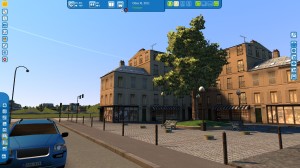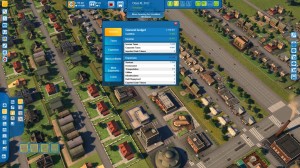I’ve been playing “Cities XL 2011” off and on for the past few years, having first acquired it through “Impulse” (which now sports the “GameStop App”). I wasn’t sure what to make of “Cities XL 2011” at first, though my first impressions of it at the time was that it bore an uncanny resemblance to “City Life” released back in 2006. Having done a little research for this article, I wasn’t surprised to learn that Monte Cristo was the publisher behind both games. At any rate, I decided to dive back into this title, namely due to the unsatisfied taste that the most recent “SimCity” left in my mouth. The question remains: “Is ‘Cities XL 2011’ better than EA’s most recent and controversial “SimCity” release?”
First, let’s get the SecuROM B.S. out of the way first. After installing and launching “Cities XL 2011”, I was prompted to activate my product with the serial key. OK, I could live with that…some Steam games require the same kind of activation. In this case however, the activation failed despite me copying and pasting the serial key from my GameStop browser. The problem wasn’t the serial key itself, but the automatic activation process. The manual activation step required that I find my serial number in GameStop’s browser, then visit THIS LINK. Once on SecuROM’s site, I had to paste both my serial number and the unlock request code from the “Cities XL 2011” pop-up window in order to get my activation code. From there, I had to copy and paste said activation code back into the “Cities XL 2011” pop-up window…pain in the behind if you ask me.
Once I was past that step, I began having a much better time. I found that I could create cities all over the globe, each with their own resources that can be developed and traded. The most recent “SimCity” has the feature too, but not on such a large scale. “SimCity” limits you to having about a dozen cities in a region, at most. Even “SimCity 4” gave me more wiggle room when it came to creating numerous cities in a region, and that was released in 2003. “Cities XL” provided me with many more options than “SimCity” ever did and even included a filter so that I can find the city with the characteristics I wanted. “Cities XL 2011”: 1, “SimCity”: 0.
Trading between cities, I must admit, took me a while to get. Every resource you generate (be it workers, material, holiday, buildings, etc.) has a supply and demand value associated with it in the form of tokens. Rather than bombard you with large numeric values, the game converts the amount of resources you have of a particular type into tokens. Having a profit of say, 13000, might net you 400 or so cash tokens. Having a surplus of skilled workers might net you 1 or 2 tokens, depending on the amount of the surplus. Any time you have a surplus (or making more than your demand), you are said to be producing tokens. Using the in-game trade screen, you can transfer or trade these tokens between your various cities. The game includes a bogus “Omnicorp” you can trade with, if you are just starting your first city. Since every city has different resources (farmland, water, oil, etc.), you’ll need to actively trade your tokens in order to satisfy supply and demand. In “SimCity”, trading between cities in a region was tedious at best, when it decided to work at all. “Cities XL 2011”: 2, “SimCity”: 0.
“Cities XL 2011” differs from “SimCity” in that it puts a heavier emphasis on balance. “SimCity” dumbs things down with residential, commercial, and industrial zones with a few city services to plop down every now and again. “Cities XL 2011” incorporates a class system, consisting of unskilled, skilled, executive, and elite workers. There are also different levels of density available, though like everything else in this game, you’ll have to unlock them by attracting more people to your city. Instead of commercial and industrial zones, you have retail, heavy industry, manufacturing, offices, and so on. Each commercial or industrial structure requires a particular worker class (or two). Having a bunch of office buildings in your city won’t do you much good with only unskilled workers at your disposal. “Cities XL 2011” required that I pay attention a bit more to the type of structures I had in my city. Plopping down medical, fire, police, power, retail, and other services are still possible (and required)…though you’ll have to strategically place them to keep your citizens happy. “SimCity’s” method is admittedly easier and has a more shallow learning curve, but hardcore sim fans will enjoy the extra level of detail that “Cities XL” has to offer. As such, I’ve decided to declare this category a tie. “Cities XL 2011”: 2, “SimCity”: 0.
In terms of graphics, I was VERY pleased by what “”Cities XL 2011” had to offer. I could actually zoom down to the street level and watch the traffic and bystanders go about their business. Each structure had a certain level of detail that I found captivating. “Cities in Motion 2” does something similar and I’m glad to see it here too. When I need a break from building, I can just let the city life carry me away with a simple scroll of the mouse wheel. “SimCity Societies” had a street level view, though “SimCity’s” was admittedly a bit lacking. The financial and demographic reports are also much more in-depth, though they aren’t difficult to read. The interface is also very user-friendly, I feel. It’s clearly obvious to me that the clear winner here is “Cities XL 2011”, by a longshot. “Cities XL 2011”: 3, “SimCity”: 0.

Experience the beautiful environment you craft, or take a stroll through your smoke inducing industry sector…
City size is a touchy issue and both “SimCity” and “Cities XL 2011” have the same problem…though the former actually addresses it. Much to many fans’ dismay, EA announced that they could not increase a region’s city size due to the slowdowns that would occur once the city reached a certain level of growth. While this does irk me a bit, I’m glad that at least EA is acknowledging the problem. Monte Cristo, based on user feedback in the Steam forums, is less responsive to problems and complaints than EA (if you can believe that). While the scope of a city is absolutely HUGE in “Cities XL 2011”, there will come a point where your PC will start chugging, thereby causing your frame rate to take a significant hit. The game is playable in the first few hours, but once your city size reaches a certain point, some folks may have difficulty getting the game to respond properly…at least I did (my gaming laptop is pretty powerful, for the record). In the end, this category comes out to be a tie, as both have issues with city size despite both addressing them (or not) differently. “Cities XL 2011”: 3, “SimCity”: 0.
When it comes down to it, “Cities XL 2011” (when compared to “SimCity”) is the better game, in my opinion. “Cities XL 2011”, despite having the SecuROM activation step, doesn’t require an always online connection…as it SHOULD be. There are a few bugs with the game: roads refusing to connect at times or achievement text not displaying properly…though these are issues I can deal with. My main beef with the game is the lag and frame rate drop you’ll receive once your cities reaches a certain size….which is a real shame. “Cities XL 2011” offers so much and would have scored a 9/10 from me had it not been for this glaring and significant problem. All in all, “Cities XL 2011” is a great city-builder that will indeed give you a lot of playtime. For twenty bucks, it’s honestly not a bad deal considering that “SimCity” is more than double that price (as of 12/24/13). Further, it’ll be five bucks on Steam until January 2, 2014…grab it while you can!
Final Verdict: 8/10
—
You can learn more about and purchase “Cities XL 2011” by visiting the following websites:
http://store.steampowered.com/app/58510/
—
http://www.youtube.com/watch?v=awoEm4U3arE
—


